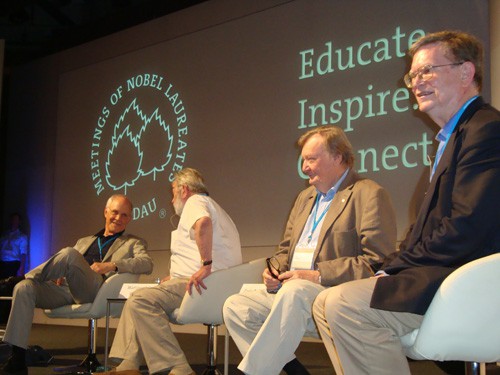
Chewing the fat: (left to right) David Gross, Martinus Veltman, Carlo Rubbia and George Smoot
By Matthew Chalmers in Lindau, Germany
The organizers of this year’s 62nd Lindau Nobel Laureate Meeting couldn’t believe their luck. Having invited 27 Nobel-prize winners (average age 73.5) plus 600 young physicists to an island in Lake Constance, what should happen right in the middle of their shindig but the announcement of the biggest physics discovery in a generation. CERN’s new boson created quite a stir on the island, and it would seem that a certain Peter Higgs could soon be among the annual event’s invitees.
David Gross, who shared the 2004 prize for his work on the strong interaction, hasn’t stopped smiling, and is sure that CERN has discovered a Higgs – if not the Higgs boson as predicted by the Standard Model of particle physics. “This is a great day for me, for physics and for all of humanity,” he enthused on Wednesday after the news emerged.
Gross is particularly happy because the mass of the new particle (125 GeV) suggests that his favourite candidate for a deeper theory of physics – supersymmetry – is on the money. However, he also admitted that this particular mass value, should the particle indeed turn out to be the Higgs, would imply that the universe is in a metastable state that could decay at any moment and cause everything we know to simply disappear. The prospect prompted hearty laughter from the crowd.
Particle-physicist heavyweight Carlo Rubbia – who was responsible for the discovery of the W and Z particles at CERN in 1983, for which he picked up a Nobel prize the following year – was not getting too caught up in the elation. He wants to know why CERN’s new boson appears to be produced at a rate twice as large as would be expected. “The Standard Model should give us an exact value for this, and here there is a direct disagreement: what’s going on?” he asked. No stranger to getting major particle-physics experiments off the ground, he demanded a dedicated new collider to pin down its properties.
The third Nobel-prize-winning particle physicist at this year’s meeting was Martinus Veltman, who shared the 1999 gong for his work on the electroweak sector of the Standard Model (for which the Higgs is crucial). Veltman had not yet organized his thoughts on the discovery – indeed, he seemed somewhat subdued about the affair. “The Standard Model has now got a degree of validity that has extended way beyond what we had before the Higgs,” he said. “However, the one aspect that dominates here is that a Higgs could close the last door of the Standard Model that could lead us to a deeper theory.”
But not all Nobel laureates at the meeting were so elated. Condensed-matter physicist Robert Laughlin, who shared the 1998 prize for the discovery of a new form of quantum fluid, thinks that particle physics is in trouble, no matter what is discovered at the Large Hadron Collider. His view is that governments justified “big physics” research for defence reasons because particle physics followed nuclear physics, which had given countries the bomb. “Those motivations are less obvious today, which is good for the world but bad for the field in the long term,” he told physicsworld.com.
Meanwhile, the UK’s Harry Kroto, who shared the 1996 chemistry prize for the discovery of fullerenes, is worried about the cash and publicity consumed by big physics. “I do see that the [Higgs] discovery is wonderful, but I also see the huge amounts of money going into this field, and I wonder whether we are getting the balance right when it comes to science funding,” he told physicsworld.com. “I’m concerned, given the current funding situation, that large numbers of chemists doing fundamental work will lose out.”



